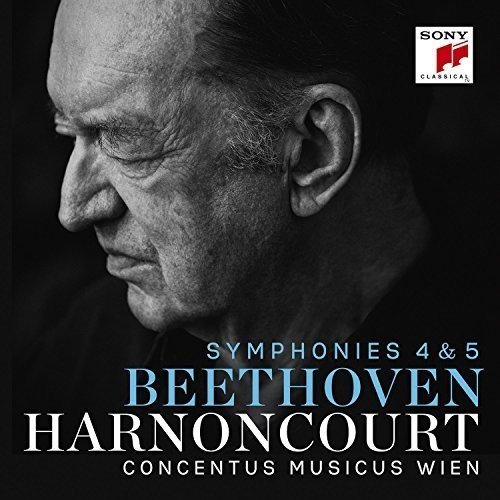BEETHOVEN Symphonies Nos 4 & 5
View record and artist detailsRecord and Artist Details
Composer or Director: Ludwig van Beethoven
Genre:
Orchestral
Label: Sony Classical
Magazine Review Date: 02/2016
Media Format: CD or Download
Media Runtime: 71
Mastering:
DDD
Catalogue Number: 88875 13645-2

Tracks:
| Composition | Artist Credit |
|---|---|
| Symphony No. 4 |
Ludwig van Beethoven, Composer
Ludwig van Beethoven, Composer Vienna Concentus Musicus |
| Symphony No. 5 |
Ludwig van Beethoven, Composer
Ludwig van Beethoven, Composer Vienna Concentus Musicus |
Author: Richard Osborne
The principal casualty of his retirement has been the cycle of the nine Beethoven symphonies he was planning to give with his own Concentus Musicus Wien in Graz in June 2016. His 1990-91 cycle made with the Chamber Orchestra of Europe (Teldec/Warner, 11/91) is as fine as any in modern times. But for a musician who has been exploring period practice since the 1950s (Harnoncourt and his wife founded Concentus Musicus in 1953), it would have been fascinating to hear him close the circle with a period view.
The new account of the Fourth Symphony nicely complements the older Chamber Orchestra of Europe version. The reading itself is much as before, perfectly vital and serene. What is different is a more purposeful tread to the rhythms and some fresh voicings of wind and brass. The orchestra play superbly, though I suspect that the added gravitas has more to do with Harnoncourt’s late delvings than with changed sonorities as such.
In the Fifth Symphony the orchestra seems underpowered at first, as if this were one of Haydn’s ‘London’ Symphonies rather than Beethoven at full throttle a decade later. The upper strings seem undernourished throughout, just as the winds and, more particularly, the brass become ever more explosive. In the finale it is the trombones that are given their head, firing broadsides with a fierceness of report the cannons on Nelson’s Victory would have been proud to deliver. Yet, for all that this is a symphony created in a time of war, such effects are often exaggerated in a way they are not in Harnoncourt’s superlative 1990 performance. Tempi, too, were better integrated in that earlier performance. The new quicker pulse of the third movement trivialises the Scherzo’s return midway through the finale, draining it of menace.
And then there is Harnoncourt’s late-flowering love of the ‘General Pause’. ‘Today I have reached the stage where in works of this period I give special emphasis to every General Pause,’ he announces in the booklet. There is a hint of this at the start of the third-movement Trio as the double basses dig into the preliminary crotchet C then halt. But that is nothing to what happens at the symphony’s end. In the final 13 bars Harnoncourt introduces a series of general pauses between some (but not all) of the C major chords, stopping Beethoven’s peroration in its tracks. The effect is the kind of rhythmic disjunction we expect to hear the end of Sibelius’s Fifth, not Beethoven’s.
It’s what the Generalpause is designed to do, of course, yet there is not a shred of evidence – nor does Harnoncourt offer any – that this is what Beethoven wanted. You may thrill to the effect, though as Dr Johnson warned, ‘It has long been found that specious emendations do not equally strike all minds with conviction.’
That said, I’m rather relieved to hear Harnoncourt going out with a bang rather than a whimper. He is too courageous a musician to have done anything less.
Discover the world's largest classical music catalogue with Presto Music.

Gramophone Digital Club
- Digital Edition
- Digital Archive
- Reviews Database
- Full website access
From £8.75 / month
Subscribe
Gramophone Full Club
- Print Edition
- Digital Edition
- Digital Archive
- Reviews Database
- Full website access
From £11.00 / month
Subscribe
If you are a library, university or other organisation that would be interested in an institutional subscription to Gramophone please click here for further information.




